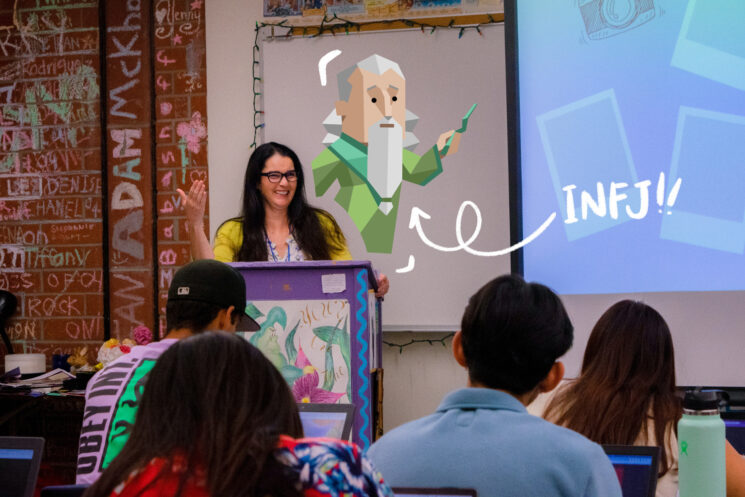
By Myra Chen
What we perceive may not always be true, evident in the results of the Myers-Briggs Type Indicator (MBTI) test at Fountain Valley High School (FVHS). Your very own teachers, notorious for being energetic and vocal, may be an introvert at heart.
With a 91.2% accuracy rate, the MBTI four-lettered code broadly encapsulates one’s daily preferences: whether you tend to focus inwardly or outwardly, how you take in information, how you make decisions and how you live your life. Out of the 36 teachers asked to send their most recent MBTI code, 14 responded. And of these 14 teachers perceived to be extroverts, 11 were introverts. So what makes human perception and reality differ so drastically in the realm of personality? The short answer is: perception is often flawed by persona. Hiding behind a mask, teachers are rarely how they present themselves in a professional setting.
Spanish teacher Sheila Bunten is one of the few cases where expectations are aligned with reality. She’s caring, understanding and empathetic. Using entertaining methods, Bunten makes Spanish easy for her students to learn.
“She often sings in class and is always happy. She also approaches her students often, making me think that she is an extrovert,” junior Taylor Nguyen said.
It comes as no surprise to Nguyen that Bunten is an ESFJ, a consul whose key features are her friendliness and outgoing personality. However, the consensus between expectations and reality can’t be said about the majority of FVHS teachers.
“She is most definitely an extrovert, [she’s] interactive, bubbly and outgoing,” senior Tina Nguyen said.
Social studies teacher Julie Chaicharee’s small stature does not stop her from having the largest energy in any classroom setting. She implements humor into her lessons, constantly encouraging her students to participate. It shocks Tina Nguyen and fellow students that Chaicharee is in fact, an INFJ, an introvert.
“I feel lied to, all of a sudden. I guess I don’t know her as well as I thought, even though I’ve grown close to her as her student first and teacher assistant second,” Tina Nguyen said.
This finding continues through different teachers within different core subjects. Spanish teacher Jim Diecidue is known to interact with each student on a personal level and continues to reach out to students from previous years. His memory and kindness name him to be junior Allyson Le’s favorite teacher.
“His class was always engaging, in a way where you couldn’t slack off, but at the same time it wasn’t boring,” Le said. “He initiated conversation and looked happy to talk to us, so I knew he was someone I could go to for help.”
Diecidue is reliable, generous and most notably, an extrovert. So it seems. When Le learned of the fact that he is among the many introverted teachers, she doubted it was true because he prioritizes a student-teacher relationship above all else. Even after confirmation that he was an INTJ was given, she was reluctant to make sense of it.
If you had the pleasure of being a student of Calculus teacher Thomas Ngo, you would know that he laughs a lot. An awkward, slightly forced laugh, but a laugh nonetheless.
“He’s probably an extrovert. He goes out of his way to get to know every student within the first few days of school and is very vocal,” junior Caitlynn Year said. “[Ngo] is easy to approach because he is a very smiley person and he seems happy to be teaching.”
To her surprise, Ngo is an ISTJ, or a logistician, known for disliking flash and excessive attention. Unfortunately for him, however, paying attention to the teacher is vital to passing calculus.
She may be strict, she may be detail-oriented, but both qualities don’t outshine her liveliness. English teacher Amy Futagaki plays upbeat Charlie Brown music in class and has a brilliant stage presence, attracting the likes of senior Priscilla Le, an extrovert herself. But Futagaki is none other than an advocate, an INFJ, who possesses an astonishing 100% introverted result.
“It doesn’t make sense in my mind that she is an introvert,” Priscilla Le said. “She is very loud and has no trouble speaking her mind.”
Priscilla Le and other students note that it was almost impossible to find Futagaki between classes, during break, during lunch or after school. An attempt to recharge and avoid her source of loud stimuli, a.k.a. students? Maybe, maybe not.
Introverts are typically said to be reserved, easily flustered individuals who enjoy spending time alone. But this definition is not black and white. They can be welcoming, cheery and expressive on the surface. The difference between extroverts and introverts is the way they handle themselves behind the scenes alongside how they prefer to present themselves in front of their students.
Introversion is not always obvious. In the case of FVHS teachers, it’s a quality most commonly hidden from students, or at the very least, hidden from shallow perception. Peeking through one’s persona, some aspects of introversion may be more prevalent than others, such as urging for a quiet classroom environment, engaging in one-on-one conversations and having a short social battery life span.
Be mindful of volume in class, especially towards the end of the day. The higher a teacher’s decibel of sound is, the higher an introverted teacher’s level of frustration is. So before you barge into your favorite teacher’s locked doors, take a second and reflect on the reason why they are closed. (Hint: conversations with students are exhausting).





